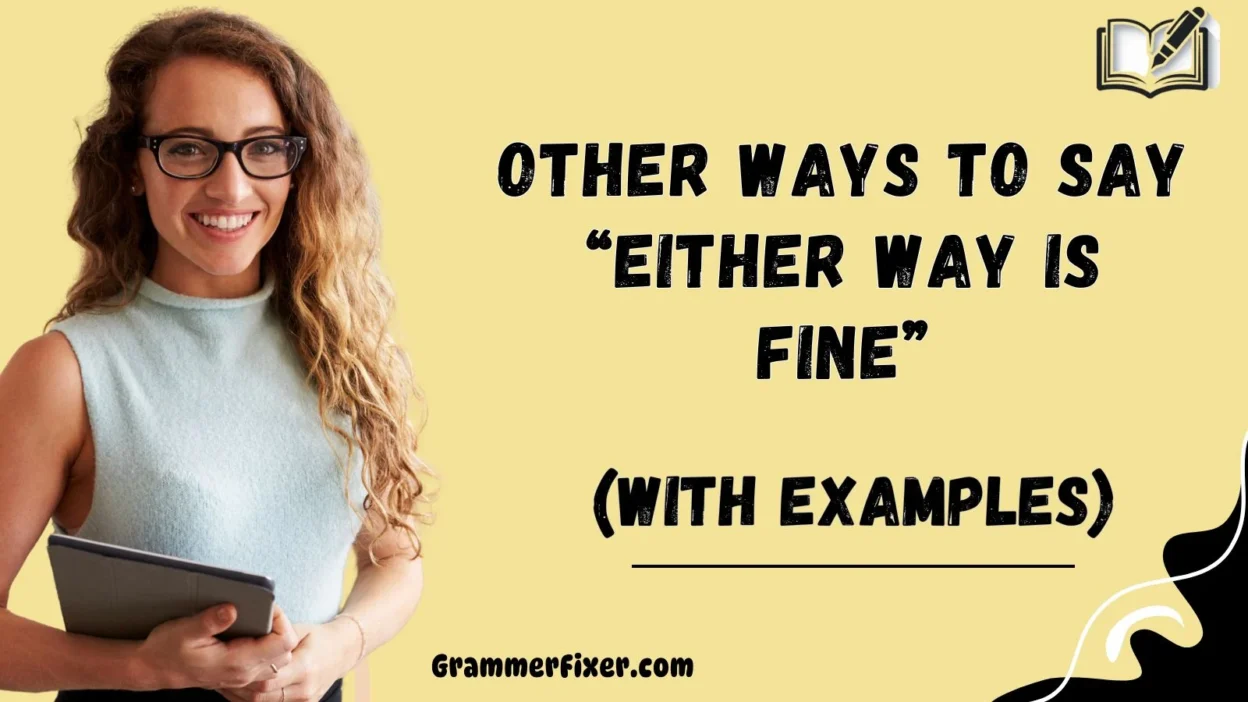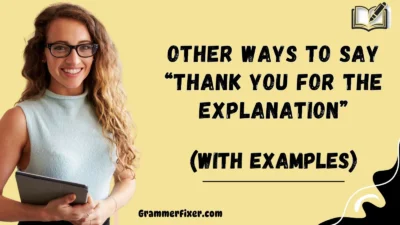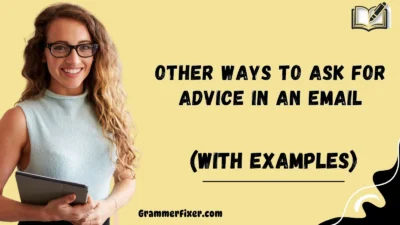Choosing the right words when communicating can make a significant difference in how your message is received. Saying something like “Either way is fine” may seem simple, but finding alternative ways to express flexibility, care, and openness can make your communication feel more personal, thoughtful, and professional.
This article explores 30 formal alternatives to this phrase, along with their meanings, scenarios, best and worst use practices, and tone to help you communicate with clarity, empathy, and sophistication.
What Does “Either Way Is Fine” Mean?
“Either way is fine” expresses indifference or flexibility between two or more options. It conveys that the speaker has no strong preference and is willing to accept any choice made by the other party. While simple, this phrase can sometimes seem casual or nonchalant, which is why using more formal or polished alternatives can enhance professional communication.
When to Use “Either Way Is Fine”?
This phrase is best used in situations where you want to show cooperation, adaptability, and respect for someone else’s choice. Examples include:
- Responding to meeting times proposed by a colleague.
- Discussing project approaches with clients.
- Choosing restaurant venues or locations for informal team gatherings.
Using formal alternatives can improve the tone when dealing with professional or corporate settings, while still conveying a friendly, approachable demeanor.
Is It Professional/Polite to Say “Either Way Is Fine”?
Yes, but context matters. In casual internal emails or messages among peers, the phrase works fine. In formal business communications, it can sometimes come across as indecisive or disengaged. Opting for more refined or structured alternatives demonstrates thoughtfulness, respect, and professionalism.
Pros and Cons
Pros:
- Shows flexibility
- Encourages collaboration
- Reduces potential conflict
Cons:
- Can appear indecisive if overused
- May be perceived as uninvolved in decision-making
- Could lack clarity in high-stakes situations
1. I Have No Preference
Meaning: You do not favor one option over another.
Explanation: This phrase communicates neutrality and respect for others’ choice.
Scenario Example: “Regarding the venue for the team lunch, I have no preference—please choose what works best for everyone.”
Best Use: Emails, meetings, and collaborative decisions.
Worst Use: High-stakes decisions where your input is critical; it may appear disengaged.
Tone: Neutral, professional, cooperative
2. I Am Indifferent to the Outcome
Meaning: You are open to any option.
Explanation: Highlights a detached, unbiased stance, making the decision easier for others.
Scenario Example: “I am indifferent to the outcome of the marketing strategy; I trust your expertise.”
Best Use: Professional emails or discussions where input is delegated.
Worst Use: Collaborative settings where active engagement is expected, as it may seem cold or uninterested.
Tone: Objective, courteous
3. Both Options Are Acceptable
Meaning: Either choice is satisfactory.
Explanation: Emphasizes that all presented alternatives meet your requirements.
Scenario Example: “Both options are acceptable; please proceed with whichever suits the timeline.”
Best Use: Project planning, internal approvals.
Worst Use: Decisions requiring clear preference or prioritization, as it may delay resolution.
Tone: Formal, cooperative
4. Whatever You Decide Is Fine
Meaning: Shows trust in the other person’s judgment.
Explanation: Indicates willingness to defer, fostering a collaborative atmosphere.
Scenario Example: “Whatever you decide is fine for the schedule adjustment, I’ll follow along.”
Best Use: Team discussions or minor decision-making.
Worst Use: Major strategic decisions where your input is essential; may appear noncommittal.
Tone: Friendly, supportive
5. I’m Comfortable With Either Option
Meaning: You are at ease with any of the alternatives.
Explanation: Communicates flexibility without sounding indifferent.
Scenario Example: “I’m comfortable with either option for the client presentation.”
Best Use: Meetings, presentations, planning discussions.
Worst Use: Situations where decisiveness is valued, as it could be seen as hesitant.
Tone: Confident, professional
6. I’m Okay With Either Choice
Meaning: Expresses consent and neutrality.
Explanation: Slightly less formal, yet still professional in many contexts.
Scenario Example: “I’m okay with either choice for the venue.”
Best Use: Internal team communications or casual client interactions.
Worst Use: Critical project decisions, as it may appear uninvolved.
Tone: Casual-formal balance, approachable
7. I’m Fine With Either Option
Meaning: You are agreeable to any outcome.
Explanation: Signals flexibility, suitable for routine decision-making.
Scenario Example: “I’m fine with either option for the marketing proposal.”
Best Use: Low-impact decisions or scheduling matters.
Worst Use: High-stakes or leadership decisions, could be perceived as indecisive.
Tone: Neutral, cooperative
8. Whichever You Prefer Works for Me
Meaning: You defer the choice to the other person.
Explanation: Shows respect and trust, highlighting flexibility.
Scenario Example: “Whichever you prefer works for me for the venue selection.”
Best Use: Collaborative team discussions, client interactions.
Worst Use: Situations requiring decisive input, as it may appear noncommittal.
Tone: Polite, accommodating
9. Either Choice Is Satisfactory
Meaning: Both options are acceptable and meet your standards.
Explanation: Formal phrasing that communicates neutrality and professionalism.
Scenario Example: “Either choice is satisfactory for the project deadline.”
Best Use: Formal emails, reports, approvals.
Worst Use: Situations needing a clear recommendation, might seem detached.
Tone: Professional, neutral
10. I Leave the Decision to You
Meaning: You willingly let the other party decide.
Explanation: Conveys trust and deference, promoting a collaborative atmosphere.
Scenario Example: “I leave the decision to you regarding the venue selection.”
Best Use: Senior-to-junior delegation or flexible team decisions.
Worst Use: When leadership expects active guidance, may appear uninvolved.
Tone: Respectful, supportive
11. I Have No Strong Feeling Either Way
Meaning: You are neutral about the choice.
Explanation: Communicates indifference without disengagement.
Scenario Example: “I have no strong feeling either way about the project timeline.”
Best Use: Routine scheduling or low-impact decisions.
Worst Use: Strategic discussions where clear opinions are needed, may appear apathetic.
Tone: Neutral, polite
12. I’m Easy Either Way
Meaning: Flexible and agreeable to either option.
Explanation: Less formal, conveys approachability and calmness.
Scenario Example: “I’m easy either way for the lunch meeting time.”
Best Use: Informal office conversations, team social plans.
Worst Use: Formal decision-making, could seem too casual or indecisive.
Tone: Casual, friendly
13. I’m Good With Either Option
Meaning: You are agreeable and flexible.
Explanation: Informal phrasing, expressing cooperation.
Scenario Example: “I’m good with either option for the schedule adjustment.”
Best Use: Informal internal communications.
Worst Use: Formal emails or presentations, might appear too casual.
Tone: Friendly, approachable
14. I’m Fine With Whatever You Choose
Meaning: Shows trust and deference to the other party.
Explanation: Communicates flexibility while maintaining politeness.
Scenario Example: “I’m fine with whatever you choose for the team outing location.”
Best Use: Team decision-making, minor planning discussions.
Worst Use: Leadership or high-stakes decisions, may seem uninvested.
Tone: Supportive, cooperative
15. I’m Open to Either Option
Meaning: You are receptive to any choice.
Explanation: Conveys flexibility and willingness to collaborate.
Scenario Example: “I’m open to either option for the client presentation approach.”
Best Use: Brainstorming sessions, project planning.
Worst Use: When a clear stance is required, could be perceived as noncommittal.
Tone: Professional, accommodating
16. I’m Fine With Either Approach
Meaning: You are agreeable to any proposed method.
Explanation: Shows flexibility in process while maintaining professionalism.
Scenario Example: “I’m fine with either approach for the campaign strategy.”
Best Use: Collaborative team projects.
Worst Use: Decision-making requiring authoritative guidance, might seem passive.
Tone: Cooperative, neutral
17. Either Option Works Well for Me
Meaning: Both alternatives are acceptable and suitable.
Explanation: Formal phrasing expressing neutrality and adaptability.
Scenario Example: “Either option works well for me regarding the meeting date.”
Best Use: Emails, project planning, formal settings.
Worst Use: When your preference matters, might appear detached.
Tone: Professional, polite
18. I’m Flexible With Either Choice
Meaning: You are adaptable and open to either option.
Explanation: Highlights willingness to accommodate others.
Scenario Example: “I’m flexible with either choice for the training session schedule.”
Best Use: Collaborative, dynamic environments.
Worst Use: Structured processes requiring definitive input, could appear indecisive.
Tone: Accommodating, approachable
19. I’m Fine With Any Option You Prefer
Meaning: You defer to the other’s judgment while expressing agreement.
Explanation: Communicates trust and cooperation.
Scenario Example: “I’m fine with any option you prefer for the client meeting venue.”
Best Use: Delegated decision-making, team planning.
Worst Use: Situations needing direct guidance, may seem uninvolved.
Tone: Respectful, professional
20. I’m Open to Your Choice
Meaning: You allow the other person to select the preferred option.
Explanation: Shows flexibility, trust, and politeness.
Scenario Example: “I’m open to your choice regarding the presentation format.”
Best Use: Collaborative decisions, meetings with clients.
Worst Use: When your expert input is required, might seem detached.
Tone: Professional, courteous
21. I’m Fine With Whatever Works Best
Meaning: You are agreeable and defer to practicality or convenience.
Explanation: Conveys flexibility while respecting others’ judgment.
Scenario Example: “I’m fine with whatever works best for the project timeline.”
Best Use: Collaborative planning, logistics decisions.
Worst Use: Strategic or critical decisions, could appear uninvolved.
Tone: Supportive, professional
22. Either Way Suits Me
Meaning: Both options are equally acceptable to you.
Explanation: Formal phrasing that expresses neutrality and cooperation.
Scenario Example: “Either way suits me regarding the conference schedule.”
Best Use: Meetings, emails, planning discussions.
Worst Use: Decisions needing a clear preference, may seem apathetic.
Tone: Polite, professional
23. I’m Fine Either Way
Meaning: You are agreeable to any presented option.
Explanation: Simple, clear, and communicates flexibility.
Scenario Example: “I’m fine either way for the team outing.”
Best Use: Informal meetings, minor decision-making.
Worst Use: Formal communications requiring clear guidance, could appear indecisive.
Tone: Neutral, cooperative
24. I’m Okay With Whatever You Decide
Meaning: Expresses trust and deference in the other person’s choice.
Explanation: Shows willingness to follow their judgment.
Scenario Example: “I’m okay with whatever you decide for the marketing plan presentation.”
Best Use: Collaborative teamwork, minor project decisions.
Worst Use: Leadership decisions requiring active input, may appear uninvolved.
Tone: Friendly, supportive
25. I’m Comfortable With Whatever Option You Prefer
Meaning: You are at ease with any choice made by the other person.
Explanation: Polite, formal phrasing that conveys flexibility and trust.
Scenario Example: “I’m comfortable with whatever option you prefer for the client meeting venue.”
Best Use: Client-facing communications, teamwork.
Worst Use: Situations requiring decisive leadership, could appear passive.
Tone: Respectful, professional
26. Whichever Works Best Is Fine With Me
Meaning: You defer to practicality or consensus.
Explanation: Communicates flexibility, cooperation, and adaptability.
Scenario Example: “Whichever works best is fine with me regarding the project deadlines.”
Best Use: Collaborative planning, internal scheduling.
Worst Use: High-stakes or priority decisions, may seem uninvolved.
Tone: Polite, approachable
27. I’m Fine With Either Alternative
Meaning: Both options are acceptable and meet your standards.
Explanation: Formal phrasing suitable for professional and business settings.
Scenario Example: “I’m fine with either alternative for the presentation format.”
Best Use: Formal emails, project planning, approvals.
Worst Use: When active input or recommendation is required, might appear indecisive.
Tone: Professional, neutral
28. I’m Open to Either Solution
Meaning: You are flexible regarding approaches or outcomes.
Explanation: Shows adaptability and collaboration.
Scenario Example: “I’m open to either solution for the marketing campaign strategy.”
Best Use: Problem-solving discussions, brainstorming sessions.
Worst Use: When direction is expected from you, may appear passive.
Tone: Cooperative, professional
29. I’m Fine With Whichever Option You Choose
Meaning: Defers decision-making power to the other person.
Explanation: Highlights trust, politeness, and flexibility.
Scenario Example: “I’m fine with whichever option you choose for the team activity schedule.”
Best Use: Team collaboration, minor choices.
Worst Use: Critical decisions requiring your input, may seem uninvolved.
Tone: Respectful, supportive
30. I’m Comfortable With Either Outcome
Meaning: Shows flexibility and acceptance of any result.
Explanation: Polished phrasing that conveys neutrality and professionalism.
Scenario Example: “I’m comfortable with either outcome regarding the campaign approval.”
Best Use: High-level professional communication, project decisions.
Worst Use: Situations where your active guidance or opinion is expected, could appear detached.
Tone: Professional, accommodating
Conclusion
The phrase “Either way is fine” and its formal alternatives provide a way to communicate flexibility, cooperation, and professionalism. Using these alternatives thoughtfully ensures that your message conveys respect, neutrality, and support without appearing disengaged.



